
|
|
|
|
|
|
Classic Bikes
Custom Bikes
Individual
Racing Bikes AJP
AJS
Aprilia
Ariel
Avinton / Wakan
Bajaj
Benelli
Beta
Bimota
BMW
Brough Superior
BRP Cam-Am
BSA
Buell / EBR
Bultaco
Cagiva
Campagna
CCM
CF Moto
Combat Motors
Derbi
Deus
Ducati
Excelsior
GASGAS
Ghezzi Brian
Gilera
GIMA
Harley Davidson
Hero
Highland
Honda
Horex
Husaberg
Husqvarna
Hyosung
Indian
Jawa
Kawasaki
KTM
KYMCO
Laverda
Lazareth
Magni
Maico
Mash
Matchless
Mondial
Moto Guzzi
Moto Morini
MV Agusta
MZ / MuZ
NCR
Norton
NSU
Paton
Peugeot
Piaggio
Revival Cycles
Roland Sands
Royal Enfield
Sachs
Sherco
Sunbeam
Suzuki
SWM
SYM
Triumph
TVS
Ural
Velocette
Vespa
Victory
Vincent
VOR
Voxan
Vyrus
Walt Siegl
Walz
Wrenchmonkees
Wunderlich
XTR / Radical
Yamaha
Zero
Video
Technical
Complete Manufacturer List
|
Suzuki GT 380L
|
| . |
|
Make Model |
Suzuki GT 380L |
|
Year |
1974 |
|
Engine |
Two stroke, transverse three cylinder |
|
Capacity |
371 cc / 22.6 cu in |
| Bore x Stroke | 54 x 54 mm |
| Compression Ratio | 7.2:1 |
| Cooling System | Air cooled |
| Exhaust | 3 into 4, stainless steel |
|
Induction |
3 x 24mm Mikuni carburetors |
|
Ignition |
Battery and coil |
|
Starting |
Kick |
|
Max Power |
27.7 kW / 38 hp @ 7500 rpm |
|
Max Torque |
38 Nm / 3.9 kgf-m / 28 lb-ft @ 6000 rpm |
|
Clutch |
Wet, multiplate |
|
Transmission |
6 Speed |
|
Final Drive |
Chain |
|
Front Suspension |
Telescopic fork, oil dampened |
|
Rear Suspension |
Dual shocks, springs, 5-way adjustable |
|
Front Brakes |
Single 275 mm disc |
|
Rear Brakes |
180mm drum |
|
Front Tyre |
3.00-19 4PR |
|
Rear Tyre |
3.50-18 4PR |
|
Dimensions |
Length: 2090 mm / 82.3 in Width: 815 mm / 32.1 in Height: 1125 mm / 44.3 in |
|
Wheelbase |
1379 mm / 54.3 in |
|
Ground Clearance |
145 mm / 5.7 in |
|
Seat Height |
787 mm / 31 in |
|
Wet Weight |
171 kg / 377 lbs |
|
Fuel Capacity |
15 Litres / 4.0 US gal / 3.3 Imp gal |
|
Oil Capacity |
1.3 Litres / 2.7 US pt / 2.2 Imp pt |
|
Standing ¼ Mile |
13.8 sec |
|
Top Speed |
153 km/h / 95 mph |
| . |
THE SPORTING MIDDLEWEIGHTS
Honda CB550F, CB500T, Suzuki GT380, GT550, Yamaha RD400C, XS500C, and Kawasaki
KH400 Triple comparison
Other than the predictable responses that always follow the publication of a
Cycle Magazine street-bike comparison test ("You guys are full of it!"), the
most persistent. - and plaintive - comment is, "Do one on the Middleweights." So here
one is - a Middleweight Comparison Test, including two entries from Honda (CB550F
and CB500T), two from Suzuki (GT380 and GT550), two from Yamaha (RD400C and
XS500C) and one from Kawasaki (KH400 Triple). The bikes we've selected for this
comparison may or may not jibe with your idea of what constitutes a proper
Middleweight, but we feel that the selection process was valid and responsible.
To fanciers of the Honda CJ360T, Honda CB360T, Kawasaki KZ400 and Yamaha XS360C,
we say, too small, too econo-oriented. To those loyal to the Hercules Wankel
2000, the Benelli 500 Quattro and the Laverda 500 Twin, we say, too exotic.
At the center of our Comparison Test was a 1300-mile toot from our Westlake
Village offices out across the desert, then Northwest following the Sierra
mountains to San Jose, then down along the Pacific Ocean and home. The trip
lasted for five
days, during which time each of our testers rode each bike five separate times,
and had a chance to sample every bike in every kind of terrain. At the end of
the ride, the testers were asked to fill out score-sheets. Categories in which
the bikes
were evaluated were Overall Engine Performance, Overall Comfort, Fit and Feel,
Overall Noise Level, Vibration Control, Suspension Compliance, Mountain Road
Handling and In-Town Ease of Operation. Possible scores ranged from
zero - unacceptable, to nine - outstanding. The final results in each category were
determined by averaging the scores of all the testers; the overall rank order
was determined by the category scores and by the staff's subjective opinions.
Accompanying those members of the staff still able to get around after the Great
Dirt Donk Expedition were three outside experts: Bob Johnston, who had been with
us on the Donk trip and the "Eight for the Open Road" comparison (August, 1975);
Marty Dickerson, Bonneville record holder and motorcycle mechanics instructor
at the West Valley Occupational Center in Woodland Hills, California; and Bill
Ocheltree, former Motorcyclist Magazine staffer and currently a freelancer.
They were invited hopefully to offset the hell-raising tendencies of the staff;
as it turned out they raised more hell than we did, even though all three of
them are between 40 and 50 years old.
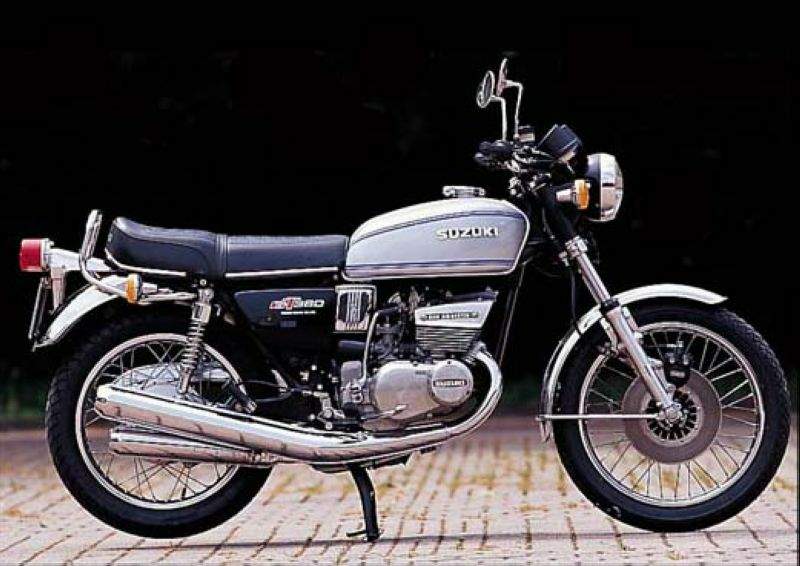
HONDA CB500T
One-time progress is a one-time thing; if ever a mechanism bore testimony to
that idea, it's the Honda CB500T. The bike came to these shores in the
mid-Sixties as the second largest displacement Japanese motorcycle (the 650cc
Kawasaki was first) of all time, and was trick beyond belief. It was a vertical
parallel twin four-stroke with double overhead cams, torsion bar valve springs
and the most complex cylinder head casting anybody had ever seen on a
motorcycle. It was ugly; Honda fixed that in short order, and by the early
Seventies the 450 was generally held to be superior in all regards: it was fast,
handled well, was easy on maintenance, had a disc front brake and was a marvel
of smoothness when matched against other bikes of the same general description
(the Triumph 500 and 650 among others).
Had Honda clung to the 450 as we knew it then and simply dragged it forward year
after year with no significant changes, chances are that, in the face of giant
strides made by Honda's now-plentiful competitors, the bike would not have fared
well. But it would have done better than the current 500T, because the old 450
was a better motorcycle.
The 500 is a cosmetic masterpiece; the T-bike is lovingly painted, plated,
styled, trimmed and striped Its appearance is its message; once you plunk your
buns on the saddle and fire up the engine, it's all downhill. The center console
vibrates itself into a blur; the footpegs and stands all stick out too far; the
bike leaps ahead and falls back with a will of its own; the brakes on both ends
need to be improved; the rubber-mounted handlebar does little to shield your
arms and hands from the engine's incessant quaking and shaking.
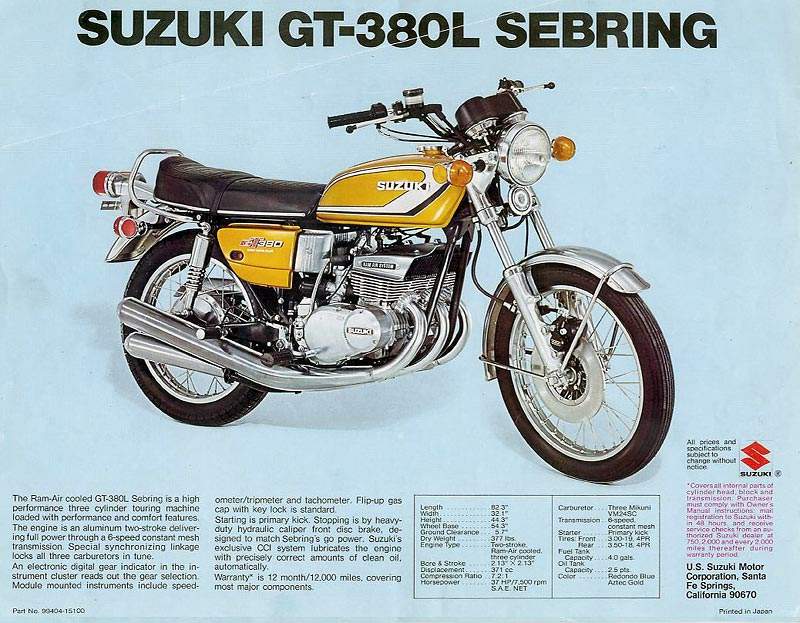
Well, you're thinking, it's probably cheap. Wrong. It costs $1610, suggested
retail, or $400 more than the RD-400C or the Kawasaki KH400. Well, maybe it's
fast. Guess again. Does it get good mileage? Yes - just under 40 mpg over the
duration of our comparison.
Only under the most carefully chosen set of circumstances could the 500T be
presented as an admirable motorcycle; it does look good, probably won't break,
and will be economical to operate and not especially fussy. But in this
displacement range, you can do so much better - as our comparison will clearly
show.
HONDA CB550F
A stunning blonde appeared on Cycle's June 1971 cover along with the first
CB500 Four, and a bold description which read "The Honda Magic Lantern Lights
Again." After electrifying the industry in 1969 with a 750 Four, Honda was back
at it two years later, injecting a massive dose of technical class and good
motorcycling into a rather ordinary collection of midsized street bikes. The
miniaturized 750 offered smaller people with smaller budgets the same prestige,
technology, reliability, comfort and grand-prix exhaust note that the heavier,
more expensive 750 had used to unseat the reigning kings of motorcycling.
Reduced size gave the 500 an important advantage over bigger bikes - agility,
nimbleness and better handling, and a strong appeal for those who could
appreciate subleties.
The little Four was a brilliant motorcycle and a big seller. Within two years
Honda updated it to performance levels reached by other brands reacting to the
original CB500, and thus the 550 was born in late 1973. The extra 50cc brought
the displacement up to Suzuki's 550, helped justify a price hike from $1500 to
$1600 and ensured that several other costly improvements would not go
unnoticed. For 1975's model year the CB550 four-piper was joined by the bike in
this test - a sportier-styled CB550F which featured a four-into-one exhaust, a new
tank, center key location, different seat and the implication that Café styling
and even higher pricing might be accompanied by more engine performance. It
wasn't. The bike still has more horsepower than any other in the test, and
engine performance equal to everything but the RD400C's acceleration and the
GT-550's top speed.
As a five-year-old basic design, the 550 is mature by Honda standards, and that
means there aren't any detail problems left. Its tiny features have come to be
expected from the Japanese, and they're there in droves on the 550F. The bike's
maturity also means you're stuck with its shortcomings, which are drive-train
snatch and dragging chassis hardware in fast right-hand corners. The gearbox,
still clunky and uncertain after five years, is another item you'll have to put
up with.
Nothing else about the bike requires tolerance. Mostly the CB550F is delightful,
but it comes at a price ($1825) - the highest in the group by 8 percent.
Nevertheless it will still sell more units than any of the others because more
dealers have it, because it's a four-stroke, and simply because it's a Honda.
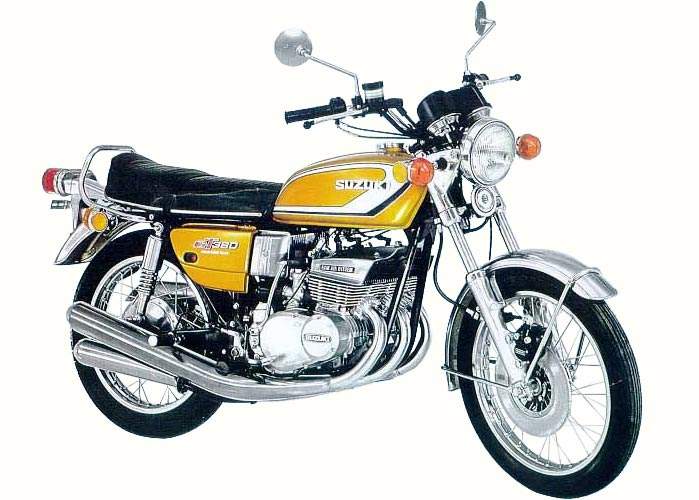
KAWASAKI KH400
The KH400 is the best of all Kawasaki three-cylinder two-strokes. To
appreciate that, you have to understand where Kawasaki was coming from in 1968,
and where they're coming from now. In the late Sixties it became evident that
Kawasaki, which had always seen itself as a performance company, was prepared
to take no prisoners in the drag-o-derby. The H-1 500 was a menacing little
monster: quick, unstable, unpredictable and terrifyingly fast. The 750cc version
debuted late in 1971, and was even better - or worse - than the 500 because it was
faster. But the 350cc triple, presented in early 1972, was somewhat tame. It was
quick and quirky, in that fine Kawasaki tradition, but it showed the first signs
of the company's willingness, having become "established," to view restraint as
a not altogether unacceptable quality. Shortly thereafter Kawasaki introduced
the Z-1 - that factory's first, quality, non-disposable motorcycle - and their
bikes have been getting more attractive ever since. The bike in question here,
the KH400, is significantly different from its predecessor and continues
Kawasaki's quest for more-decent and less-flashy equipment.
It has been freshened-up in many areas for 1976. Its air inlet system is new,
its chassis is more liberally gusseted, its muffler has been re-engineered for
better sound control, gearing has been stretched to help mileage and reduce
cruising engine speed, and the KH has been fitted with a CDI ignition system to
prolong plug life.
But even with its little package of developments and refinements, the KH
retains the kind of character that had it highly-placed in several of the
performance-intensive test categories, and ranked down near to the bottom in
the categories that emphasized comfort. It's light (the lightest in the test at
378 pounds with a full tank), inexpensive ($1239 suggested retail) and has the
kind of power-to-weight ratio (12 Ibs/hp) that guarantees invigorating
acceleration. It is also, in keeping with the larger-displacement Kawatriples
that preceded it, a bit harsh in terms of finish, styling and myriad details
which other factories handle more delicately. But crude or no, the KH is a
genuinely fun motorcycle to be around - as long as you're tuned into good
handling and hot engines.
SUZUKI GT380
The Suzuki GT380 Sebring was the first sub-400cc street bike to break away from the 350cc class rating. It was also the first mid-displacement multi-cylinder roadster from Suzuki. In the wake of the performance bikes of the early Seventies, the Sebring navigated in a very different direction, and moved toward serene performance and exceptional comfort.
In designing the GT380, Suzuki's engineers mixed fresh concepts with proven parts. The bore and stroke of the Sebring are the same as Suzuki's 250cc street twin. By adding one cylinder the displacement was bumped up to 371 cc. Mild port timing, low compression and small carburetors level out the 380's power and separate it from pipey, performance-type two-stroke engines.
The six-speed gearbox is also of the same design as the GT250 twin's. Gear spans are progressively tightened up in the higher cogs and there's nothing unusual about that, but it does allow a rider to find a gear in which the GT380 is absolutely smooth on the highway.
For all intents and purposes the engine has remained unchanged since its release in 1972. The Ram Air System has proved efficient in increasing engine heat dissipation, and more importantly, reducing operating noise. The low compression motor runs trouble-free on regular grade gasolines. Suzuki's intricate oil injection system lubricates the pistons and crankshaft bearings individually and includes a recycling arrangement which removes fuel mixture accumulation from the crankcase areas and feeds it directly into the combustion chambers.
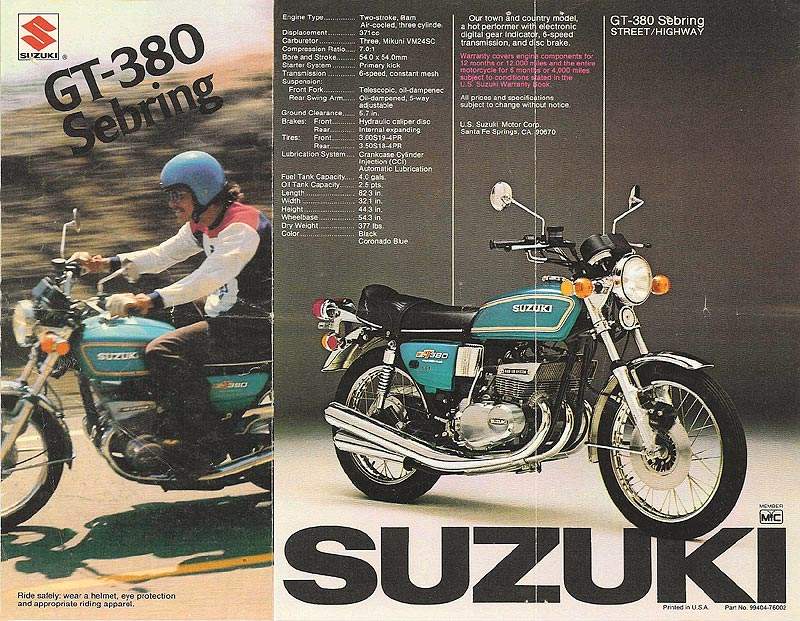
In 1974 a number of major changes were made to the chassis, carburetor intake, exhaust and instrumentation. The chassis was completely redesigned to improve handling and ground clearance. Better fork internals, shock dampers and springs delivered a better ride. New instruments were joined by the digital gear readout and larger warning lights.
Bell-crank operated carburetors replaced the cable-actuated mixers and the mufflers were moved up and in for additional ground clearance. Modifications to the intake system reduced objectionable induction drone and relocated footpegs and controls increased comfort.
Suzuki built the Sebring with a front drum brake only in its first year, moving to a disc in 1973. Rubber engine mounting is unchanged, having proven effective in eliminating vibration. The conventional triple-point ignition system is driven from an independent idler gear to prevent timing fluctuation associated with crankshaft flexing.
Initial saddle and gas tank designs have gone without alterations. Minor design improvement changes have been made to the GT380's through its five model series, but few are visible. Suzuki believes in improving the breed from the inside out, not the outside in. The GT380 has successfully survived four tough years, and Suzuki appears willing to retain the Sebring indefinitely.
SUZUKI GT550
There is little new and nothing unconventional about the '76 Suzuki GT550 Indy. It is a four-year old motorcycle that was designed to ride the waves of progress, survive as a seasoned veteran and never get out of date. Paint scheme alone identifies the 1976 Indy as new.
Suzuki's innovative design of the Ram Air cylinder head shroud system has endured, unchanged, since the beginning. Ahead of its time in 1972, the RAS provides dual benefits. The scoop increases air-flow activity over the fins, and also functions as an excellent sound-deadener to minimize the amount of top-end piston noise.
There have been no performance changes made to the cylinders or pistons since the Indy's inception. The low-compression two-stroke triple was designed for durability and runs as happily on low-or no-lead fuels as it does on premium. Unchanged since the GT550's original design is its exceptionally effective rubber mounting system.
Only one chassis change has been made to the GT550 through the five-model series. In 1974 a number of major up-dates were built into the Indy—mostly to subdue noise and improve handling. The carburetion, intake and exhaust systems were modified to reduce operating noise levels. The exhaust pipes were tucked up closer to the frame, the side stand and center stand were moved in and the foot pegs relocated to give the Suzuki additional lean angle clearance. The frame changes amounted to nothing more than relocating foot controls and brackets to which they attached.
New instruments were fitted to the Indy in 1974 and included Suzuki's popular digital gear read-out and bigger idiot lights. The five-speed gearbox is identical to the transmission in the big 750cc Suzuki LeMans. The 550's clutch and primary drive are equally robust.
Suzuki went to the disc front binder in 1973. The rear drum brake and wheel have remained unchanged, as have the tire sizes.
Electric starting was in the first 550, and has remained without alteration. Most of the electrical components are the same as those used in the 750s. The plush saddle and four gallon gas tank have been changed in very minor ways - a new piece of vinyl here and a fresh paint stripe there. Minute internal modifications appear in the parts books of each new Indy, but the motorcycle remains pleasantly the same. Unlike most re-vamped new models the GT550 has lost seven pounds since 1974 and the price has escalated only moderately. As Suzuki's most successful road bike, the GT550's reputation for dependability is a matter of record.
Source Cycle World
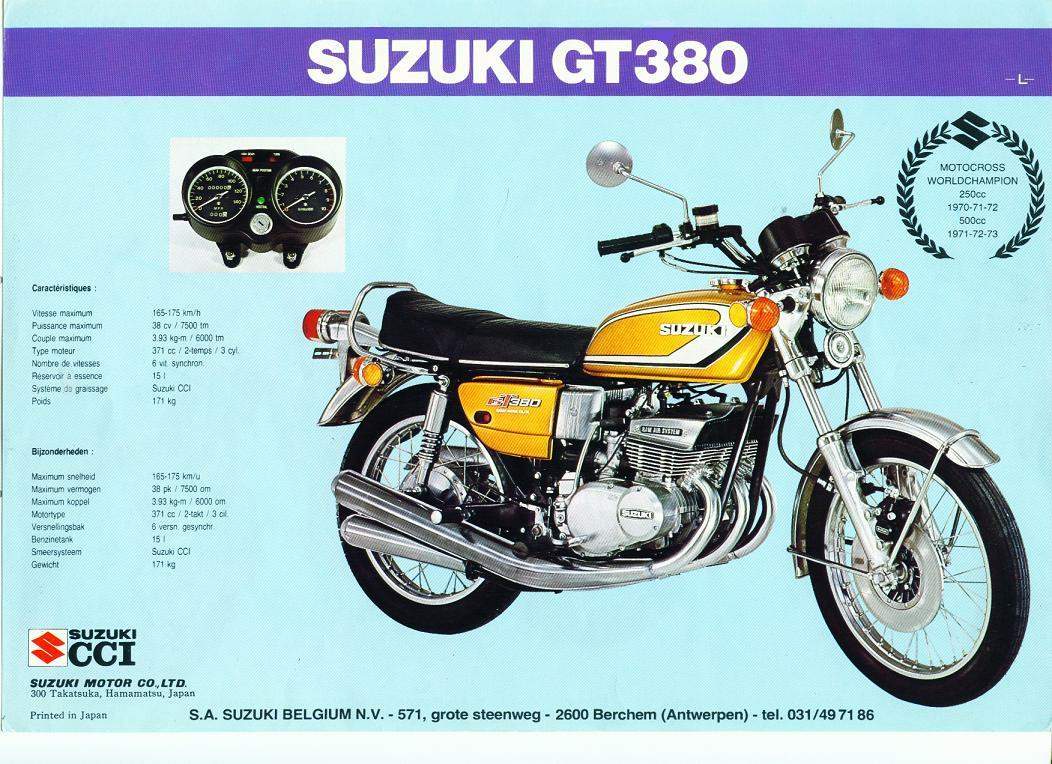
|
Any corrections or more information on these motorcycles will be kindly appreciated. |